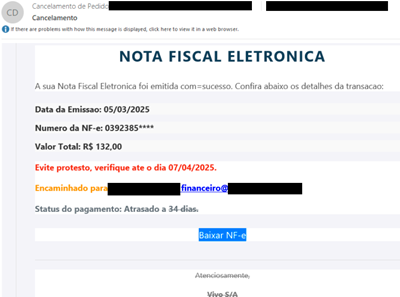Uma rota estática deve ser configura sempre apontando para o IP do next-hop. Isso é o que diz as melhores práticas para configuração de roteamento… Mas qual a diferença na prática??
Bom, sabemos que quando a rota é configurada apontando para a interface, ela tem distância administrativa 0 (diretamente conectada) e apontando para um IP terá distância administrativa será 1 (padrão para rota estática).
Rota configurada: ip route 192.168.1.0 255.255.255.0 f0/0
Entrada na tabela de roteamento: S 192.168.1.0/24 is directly connected, FastEthernet0/0Rota configurada: ip route 192.168.1.0 255.255.255.0 172.16.1.10
Entrada na tabela de roteamento: S 192.168.1.0/24 [1/0] via 172.16.1.10
Isso pode ser bom ou mau, dependendo da sua necessidade.
Mas vamos ver algumas situações onde (e porque) existem diferenças entre configurar uma rota estática para o IP do next-hop ou para a interface de saída.
1°) Imagine que você tem 10 rotas apontando para a S0/0 (interface de saída), e foi necessário mudar a interface (deu problema na interface e o link foi conectado na S0/1, por exemplo) teríamos que mudar também todas as rotas.
2°) Este problema ocorre com freqüência quando utilizamos a interface de saída na rota em conexões NÃO ponto a ponto. Por exemplo uma conexão entre um roteador e um switch, que recebe ainda a conexão de diversos dispositivos. Se você aponta a rota para sua interface de saída, o equipamento vai enviar o pacote para quem?

Na teoria o roteador BrainRT01 vai enviar um broadcast layer2 e o roteador BrainRT02 responderá (proxy-ARP). Porém isso nem sempre funciona (algum equipamento pode bloquear a requisição,por exemplo)…E se não for ethernet? Ai fica pior, e são grandes as chances do tráfego não ir para lugar nenhum.
3°) Proxy-ARP em redes do tipo broadcast. Quando configuramos a rota para a interface, o equipamento envia uma mensagem broadcast para descobrir para onde o tráfego deve ser enviando, como vimos acima. Ele fará isso para todo IP buscado através daquela rota. Por sua vez o roteador que conhece este IP ou rede (BrainRT02, no exemplo abaixo) responderá todas as requisições, fazendo o proxy-ARP (enviará o seu mac-address da interface F0/1). Com esta resposta o roteador que fez a requisição (BrainRT01) cadastra o mac-address do roteador que respondeu (BrainRT02) em sua tabela ARP, associando ao IP.
Exemplo: Rotas estáticas configuradas apontando a interface de saída.
Rotas configuradas no BrainRT01:
ip route 1.1.1.0 255.255.255.252 FastEthernet0/1
ip route 2.1.1.0 255.255.255.252 FastEthernet0/1
ip route 3.1.1.0 255.255.255.252 FastEthernet0/1
ip route 4.1.1.0 255.255.255.252 FastEthernet0/1
Do BrainRT01 vamos pingar as redes de BrainRT02, e depois ver como ficou a tabela ARP.
BrainRT01#ping 1.1.1.1
Type escape sequence to abort.
Sending 5, 100-byte ICMP Echos to 1.1.1.1, timeout is 2 seconds:
!!!!!
Success rate is 100 percent (5/5), round-trip min/avg/max = 1/3/8 ms
BrainRT01#ping 2.1.1.1Type escape sequence to abort.
Sending 5, 100-byte ICMP Echos to 2.1.1.1, timeout is 2 seconds:
!!!!!
Success rate is 100 percent (5/5), round-trip min/avg/max = 1/2/9 ms
BrainRT01#ping 3.1.1.1Type escape sequence to abort.
Sending 5, 100-byte ICMP Echos to 3.1.1.1, timeout is 2 seconds:
!!!!!
Success rate is 100 percent (5/5), round-trip min/avg/max = 1/4/9 ms
BrainRT01#ping 4.1.1.1Type escape sequence to abort.
Sending 5, 100-byte ICMP Echos to 4.1.1.1, timeout is 2 seconds:
!!!!!
Success rate is 100 percent (5/5), round-trip min/avg/max = 1/2/8 ms
BrainRT01#
BrainRT01#
BrainRT01#show arp
Protocol Address Age (min) Hardware Addr Type Interface
Internet 1.1.1.1 0 001b.d4c9.77d7 ARPA FastEthernet0/1
Internet 3.1.1.1 0 001b.d4c9.77d7 ARPA FastEthernet0/1
Internet 2.1.1.1 0 001b.d4c9.77d7 ARPA FastEthernet0/1
Internet 4.1.1.1 0 001b.d4c9.77d7 ARPA FastEthernet0/1
Internet 172.16.1.5 – 0019.aa80.28c2 ARPA FastEthernet0/1
Internet 172.16.1.6 79 001b.d4c9.77d7 ARPA FastEthernet0/1
Internet 172.16.1.1 79 000c.ce36.fb00 ARPA FastEthernet0/0
Internet 172.16.1.2 – 0019.aa80.28c1 ARPA FastEthernet0/0
BrainRT01#
Cada ping criou uma requisição ARP. Isso pode causar excesso de broadcast na rede, principalmente se a rota em questão, que está configurada apontando para a interface, for a rota default.
Veja a diferença na tabela ARP quando usamos rotas com o IP do next-hop:
Rotas configuras no BrainRT01:
ip route 1.1.1.0 255.255.255.0 172.16.1.6
ip route 2.1.1.0 255.255.255.0 172.16.1.6
ip route 3.1.1.0 255.255.255.0 172.16.1.6
ip route 4.1.1.0 255.255.255.0 172.16.1.6BrainRT01#ping 1.1.1.1
Type escape sequence to abort.
Sending 5, 100-byte ICMP Echos to 1.1.1.1, timeout is 2 seconds:
!!!!!
Success rate is 100 percent (5/5), round-trip min/avg/max = 1/4/9 ms
BrainRT01#ping 2.1.1.1Type escape sequence to abort.
Sending 5, 100-byte ICMP Echos to 2.1.1.1, timeout is 2 seconds:
!!!!!
Success rate is 100 percent (5/5), round-trip min/avg/max = 1/2/8 ms
BrainRT01#ping 3.1.1.1Type escape sequence to abort.
Sending 5, 100-byte ICMP Echos to 3.1.1.1, timeout is 2 seconds:
!!!!!
Success rate is 100 percent (5/5), round-trip min/avg/max = 1/2/8 ms
BrainRT01#ping 4.1.1.1Type escape sequence to abort.
Sending 5, 100-byte ICMP Echos to 4.1.1.1, timeout is 2 seconds:
!!!!!
Success rate is 100 percent (5/5), round-trip min/avg/max = 1/2/9 ms
BrainRT01#
BrainRT01#show arp
Protocol Address Age (min) Hardware Addr Type Interface
Internet 172.16.1.5 – 0019.aa80.28c2 ARPA FastEthernet0/1
Internet 172.16.1.6 5 001b.d4c9.77d7 ARPA FastEthernet0/1
Internet 172.16.1.1 236 000c.ce36.fb00 ARPA FastEthernet0/0
Internet 172.16.1.2 – 0019.aa80.28c1 ARPA FastEthernet0/0
BrainRT01#
Desta forma o roteador BraintRT01 precisa identificar apenas o mac-address do next-hop, e colocá-lo em sua tabela ARP, como mostrado acima.
4°) Agora imagine que na topologia abaixo temos configurado protocolo de roteamento, além das rotas estáticas. Se configurarmos as rotas estáticas para a interface e ela ficar down a rota é removida da tabela de roteamento. Por outro lado, se a rota for configurada com o IP do next-hop, mesmo que a interface F0/1 do BrainRT01 fique down, o IP do next-hop será aprendido pelo protocolo de roteamento, e a rota estática continuará na tabela de roteamento.
Exemplo: Rotas estáticas configuradas para a interface + EIGRP (todas as redes)
Rotas estáticas configuradas no BrainRT01:
ip route 1.1.1.0 255.255.255.0 FastEthernet0/1
ip route 2.1.1.0 255.255.255.0 FastEthernet0/1
ip route 3.1.1.0 255.255.255.0 FastEthernet0/1
ip route 4.1.1.0 255.255.255.0 FastEthernet0/1
BrainRT01#sh ip route
Codes: C – connected, S – static, R – RIP, M – mobile, B – BGP
D – EIGRP, EX – EIGRP external, O – OSPF, IA – OSPF inter area
N1 – OSPF NSSA external type 1, N2 – OSPF NSSA external type 2
E1 – OSPF external type 1, E2 – OSPF external type 2
i – IS-IS, su – IS-IS summary, L1 – IS-IS level-1, L2 – IS-IS level-2
ia – IS-IS inter area, * – candidate default, U – per-user static route
o – ODR, P – periodic downloaded static routeGateway of last resort is not set
1.0.0.0/24 is subnetted, 1 subnets
S 1.1.1.0 is directly connected, FastEthernet0/1
2.0.0.0/24 is subnetted, 1 subnets
S 2.1.1.0 is directly connected, FastEthernet0/1
3.0.0.0/24 is subnetted, 1 subnets
S 3.1.1.0 is directly connected, FastEthernet0/1
4.0.0.0/24 is subnetted, 1 subnets
S 4.1.1.0 is directly connected, FastEthernet0/1
172.16.0.0/30 is subnetted, 3 subnets
D 172.16.1.8 [90/30720] via 172.16.1.6, 00:04:14, FastEthernet0/1
[90/30720] via 172.16.1.1, 00:04:14, FastEthernet0/0
C 172.16.1.4 is directly connected, FastEthernet0/1
C 172.16.1.0 is directly connected, FastEthernet0/0
BrainRT01#Se a interface F0/1 do BrainRT01 ficar down (dei um shutdown antes do show ip route abaixo), as rotas estáticas são removidas.
BrainRT01#sh ip route
Codes: C – connected, S – static, R – RIP, M – mobile, B – BGP
D – EIGRP, EX – EIGRP external, O – OSPF, IA – OSPF inter area
N1 – OSPF NSSA external type 1, N2 – OSPF NSSA external type 2
E1 – OSPF external type 1, E2 – OSPF external type 2
i – IS-IS, su – IS-IS summary, L1 – IS-IS level-1, L2 – IS-IS level-2
ia – IS-IS inter area, * – candidate default, U – per-user static route
o – ODR, P – periodic downloaded static routeGateway of last resort is not set
1.0.0.0/24 is subnetted, 1 subnets
D 1.1.1.0 [90/158720] via 172.16.1.1, 00:00:22, FastEthernet0/0
2.0.0.0/24 is subnetted, 1 subnets
D 2.1.1.0 [90/158720] via 172.16.1.1, 00:00:22, FastEthernet0/0
3.0.0.0/24 is subnetted, 1 subnets
D 3.1.1.0 [90/158720] via 172.16.1.1, 00:00:22, FastEthernet0/0
4.0.0.0/24 is subnetted, 1 subnets
D 4.1.1.0 [90/158720] via 172.16.1.1, 00:00:22, FastEthernet0/0
172.16.0.0/30 is subnetted, 3 subnets
D 172.16.1.8 [90/30720] via 172.16.1.1, 00:00:22, FastEthernet0/0
D 172.16.1.4 [90/33280] via 172.16.1.1, 00:00:22, FastEthernet0/0
C 172.16.1.0 is directly connected, FastEthernet0/0
BrainRT01#Agora, se as rotas estáticas forem configuradas com o IP do next-hop, mesmo que a interface F0/1 do BrainRT01 fique down, eles permanecerão na tabela de roteamento.
Rotas estáticas configuradas no BrainRT01:
ip route 1.1.1.0 255.255.255.0 172.16.1.6
ip route 2.1.1.0 255.255.255.0 172.16.1.6
ip route 3.1.1.0 255.255.255.0 172.16.1.6
ip route 4.1.1.0 255.255.255.0 172.16.1.6BrainRT01#sh ip route
Codes: C – connected, S – static, R – RIP, M – mobile, B – BGP
D – EIGRP, EX – EIGRP external, O – OSPF, IA – OSPF inter area
N1 – OSPF NSSA external type 1, N2 – OSPF NSSA external type 2
E1 – OSPF external type 1, E2 – OSPF external type 2
i – IS-IS, su – IS-IS summary, L1 – IS-IS level-1, L2 – IS-IS level-2
ia – IS-IS inter area, * – candidate default, U – per-user static route
o – ODR, P – periodic downloaded static routeGateway of last resort is not set
1.0.0.0/24 is subnetted, 1 subnets
S 1.1.1.0 [1/0] via 172.16.1.6
2.0.0.0/24 is subnetted, 1 subnets
S 2.1.1.0 [1/0] via 172.16.1.6
3.0.0.0/24 is subnetted, 1 subnets
S 3.1.1.0 [1/0] via 172.16.1.6
4.0.0.0/24 is subnetted, 1 subnets
S 4.1.1.0 [1/0] via 172.16.1.6
172.16.0.0/30 is subnetted, 3 subnets
D 172.16.1.8 [90/30720] via 172.16.1.6, 00:00:25, FastEthernet0/1
[90/30720] via 172.16.1.1, 00:00:25, FastEthernet0/0
C 172.16.1.4 is directly connected, FastEthernet0/1
C 172.16.1.0 is directly connected, FastEthernet0/0
BrainRT01#Observe abaixo, que mesmo com a interface F0/1 desativada, as rotas permaneceram na tabela de roteamento.
BrainRT01#conf t
Enter configuration commands, one per line. End with CNTL/Z.
BrainRT01(config)#int f0/1
BrainRT01(config-if)#shutdown
BrainRT01(config-if)#end
BrainRT01#show ip route
Codes: C – connected, S – static, R – RIP, M – mobile, B – BGP
D – EIGRP, EX – EIGRP external, O – OSPF, IA – OSPF inter area
N1 – OSPF NSSA external type 1, N2 – OSPF NSSA external type 2
E1 – OSPF external type 1, E2 – OSPF external type 2
i – IS-IS, su – IS-IS summary, L1 – IS-IS level-1, L2 – IS-IS level-2
ia – IS-IS inter area, * – candidate default, U – per-user static route
o – ODR, P – periodic downloaded static routeGateway of last resort is not set
1.0.0.0/24 is subnetted, 1 subnets
S 1.1.1.0 [1/0] via 172.16.1.6
2.0.0.0/24 is subnetted, 1 subnets
S 2.1.1.0 [1/0] via 172.16.1.6
3.0.0.0/24 is subnetted, 1 subnets
S 3.1.1.0 [1/0] via 172.16.1.6
4.0.0.0/24 is subnetted, 1 subnets
S 4.1.1.0 [1/0] via 172.16.1.6
172.16.0.0/30 is subnetted, 3 subnets
D 172.16.1.8 [90/30720] via 172.16.1.1, 00:00:06, FastEthernet0/0
D 172.16.1.4 [90/33280] via 172.16.1.1, 00:00:06, FastEthernet0/0
C 172.16.1.0 is directly connected, FastEthernet0/0
BrainRT01#
Para finalizar, lembre-se que podemos configurar a rota apontando ambos, a interface de saída e o IP do next-hop.
ip route 1.1.1.0 255.255.255.0 FastEthernet0/0 172.16.1.6
Neste caso não temos problema com o proxy-ARP/excesso de broadcast e mesmo que a interface fique down, a rota passa a utilizar o IP do next-hop (desde que seja possível chegar a ele, claro).
Ufa! Até a próxima.






